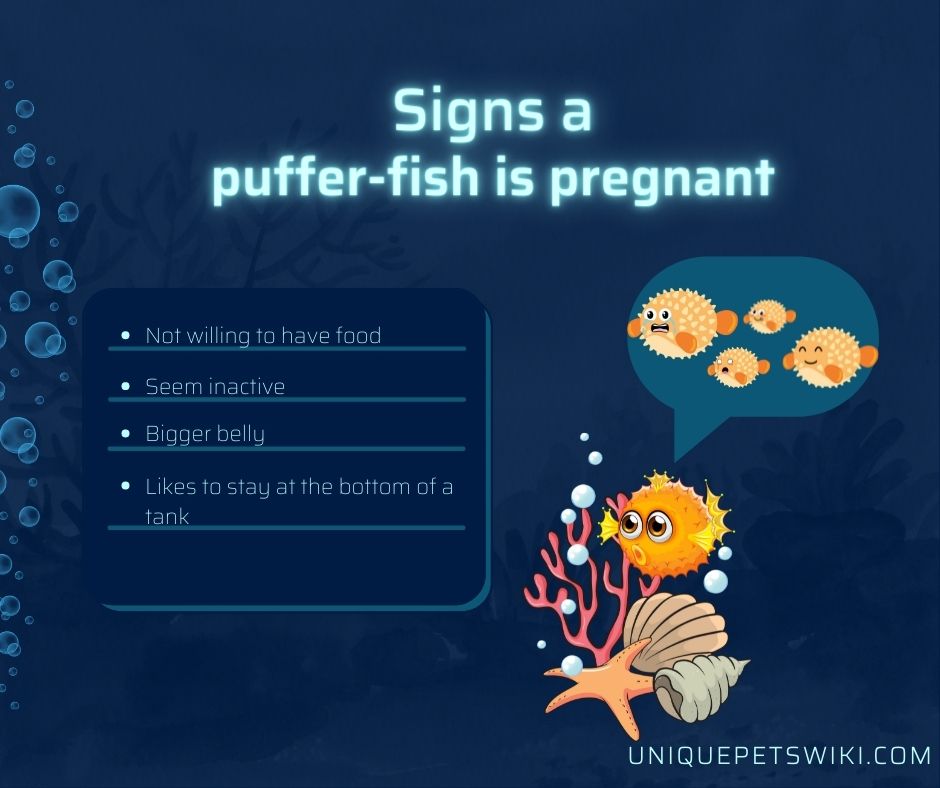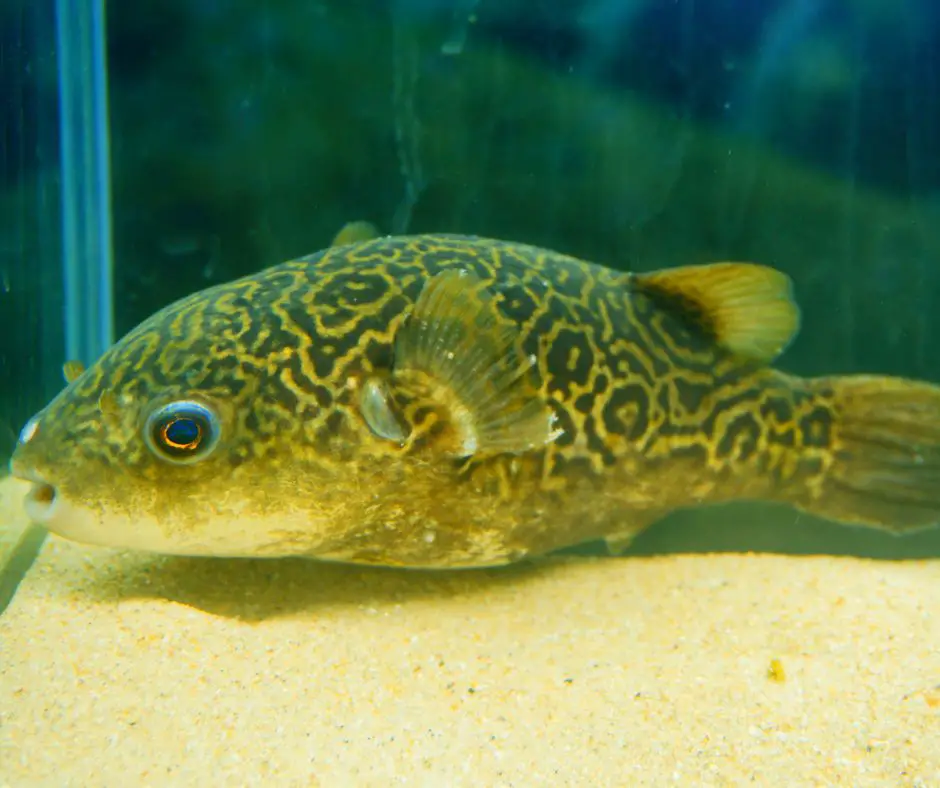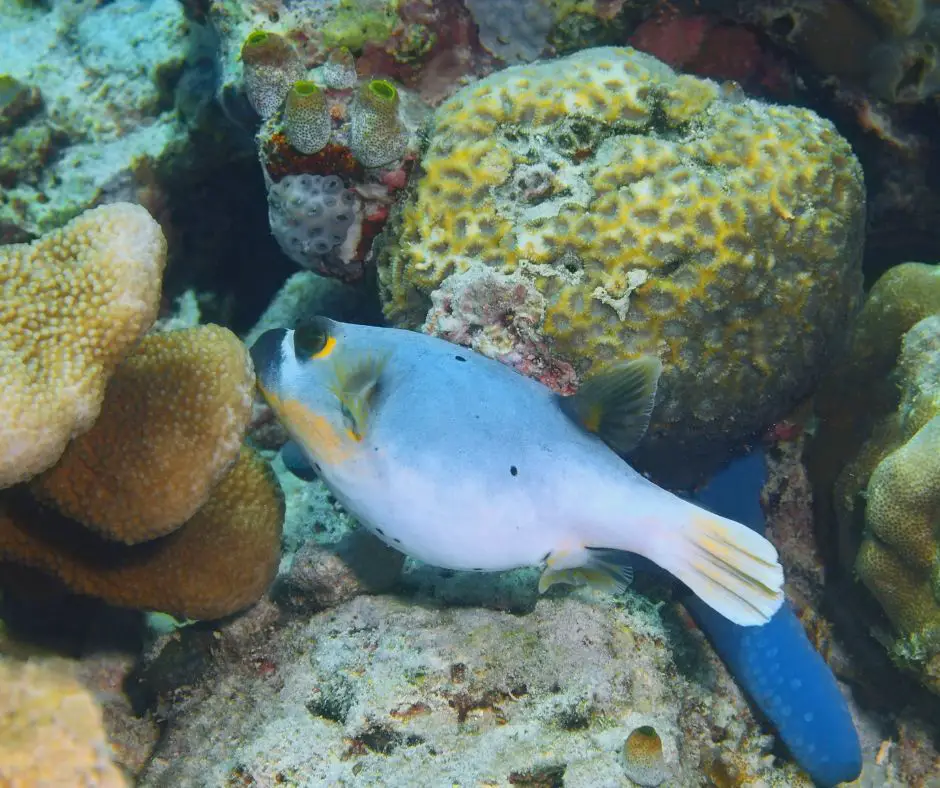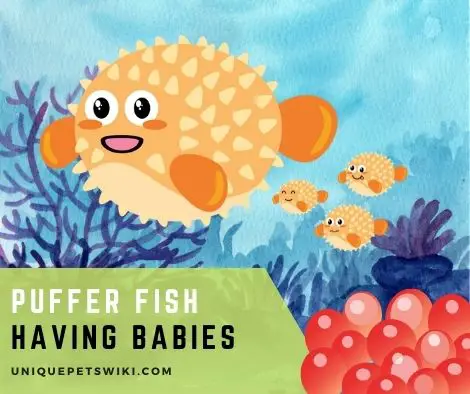One morning, I woke up to a cluster of some tiny yellow balls in my puffer fish tank. My footsteps toward the tank startled the fish to move and cause some of the balls to float.
Taking a careful look at the tiny yellow balls, they were eggs. Wow! My puffer fish having babies, I screamed!
This explains why my puffers were acting lethargic and not wanting to eat in the past two days – she was ovulating and preparing to spawn.
As a pet enthusiast, you’ll observe that many things are fascinating and special about the puffer fish. Aside from their well-known “blow up” defense mechanism, they reproduce by external fertilization.
What this means is that when the female has mature eggs, she’ll spawn them in the water and the male will push the eggs to a conducive place where he fertilizes the eggs and watches over them till they hatch.
So the big puzzle for most puffer fish owners, especially newbies, is being able to tell if their puffer fish is going to have babies? Well, if this sounds like you, then this article is your must-read.
In the end, you’ll learn how puffer fish make babies, what you can do to encourage fertilization, and how to tell you your puffer is ovulating – that is about to spawn eggs. Keep reading!
Contents
How to Tell if Puffer Fish is Having Babies

A few signs that can help you know if your puffer fish is having babies are loss of appetite, swollen/large belly, and inactivity.
When it comes to puffer fish, telling if your puffer is having babies can be tedious since the signs are not generally very prominent and obvious.
However, with careful observation and knowing what to look out for, you should know if your female puffer is going to lay eggs or not.
When you are watching your puffer fish for signs of pregnancy, make sure you are watching the right puffer which in this case is the female puffer fish.
This is because both male and female puffers look the same and telling what gender an individual fish is may be daunting. Now let’s look at these signs in detail!
Not Willing to Have Food
When ovulating and ready to lay eggs, puffer fish often don’t like eating anything. But you should note that loss of appetite doesn’t necessarily mean that your puffer is about to lay eggs, it can also be a sign of sickness.
Hence, if you observe that one of your puffer fish is not willing to have food at all, then you have to look for other symptoms to rule out the possibility of sickness. It’s possible that she’s sick. She might also be producing eggs.
If she’s going to have babies, you should keep providing optimal care by feeding proteinous foods and keeping the environment clean.
Seem Inactive
Another ovulation sign you should look out for in your puffer fish is lethargy or reduced inactivity. Female puffer fish with eggs do not move about as frequently as they used to.
So you’ll observe that your puffer prefers to stay at a point all the time, usually under plants or rocks.
Interestingly, inactivity while expecting eggs (spawning) is not seen in female puffers alone, even males appear inactive as they’ll have to watch and take care of the eggs till they hatch.
Likes to Stay at the Bottom of a Tank
Besides being inactive, a gravid puffer fish will like to stay at the bottom of the tank till the eggs are spawned.
Pufferfish require a flat, hard surface on which to lay their eggs. As a result, she’ll choose to remain at the bottom of the tank where she feels safe. Therefore, make sure your substrate is flat and hard. Avoid sandy substrates.

Bigger Belly
One final surefire sign that your female puffer fish is going to spawn eggs is an enlarged belly. You’ll notice that the size of your pufferfish has increased. This is due to the fact that it has begun to produce eggs, causing the belly to expand.
The ovipositor which is the egg-producing organ grows large and noticeable. Also, a white mark on the belly may appear.
How Long Are Pufferfish Pregnant?
Interestingly, puffer fish do not get pregnant. They only ovulate and then lay the eggs while the male puffer fertilizes the eggs externally.
Ovulation prior to laying eggs in puffer fish usually lasts for about 36 hours, which is roughly 2 days.
Unlike with other aquatic species, the male puffer fish cares for the eggs after fertilization till they hatch. He does this by fanning and protecting them from predators.
While watching over the eggs, the male puffer will separate any egg with fungus to protect the fungus from spreading to other eggs.
For this reason, it is important that you feed the male puffer fish nutritious food so he can look after the developing eggs. Foods such as live animals rich in protein should be provided.

What Do Puffer Fish Eggs Look Like?
If you are familiar with caviar, especially the albino sterlet of Caspian Sea sturgeons, then you can picture how puffer fish eggs look like.
From a distance, a cluster of puffer fish eggs appear yellow in color. This is because the embryo that is yellow in color is enclosed in a white or transparent protective shell.
How Many Babies Do Puffer Fish Have?
Typically, puffer fish lay over 1000 eggs in a single spawn. But sometimes they can lay up to 2000 eggs or more and sometimes as low as a few hundreds eggs. The number of eggs laid depends on the size of the female.
Once the eggs are laid, it takes about a week for them to hatch with all of them hatching – that is if none of the eggs was eaten by a predator because the male puffer usually stays around after fertilization to guard the eggs.
That said, if you were seeking to know how to breed pufferfish or wondering what it’ll take to raise the eggs till they hatch, then you need not worry because the process is very easy. Nonetheless, you still need to read about it.
Final Words
The puffer fish is one of the most unique fish species in the sea. They have several cool features such as blowing up their size up to three times what they were before each time they feel threatened.
They also reproduce by external fertilization.
Therefore, to know that your pufferfish is about to lay eggs, she will want to stay in one spot with little activity. She may also be unable to eat much, yet her belly will appear big.
When this happens, look out for other signs to be sure that your puffer fish isn’t sick. In sum, to ensure that your puffers reproduce seamlessly, provide good care and food during ovulation, spawning, and hatching.
